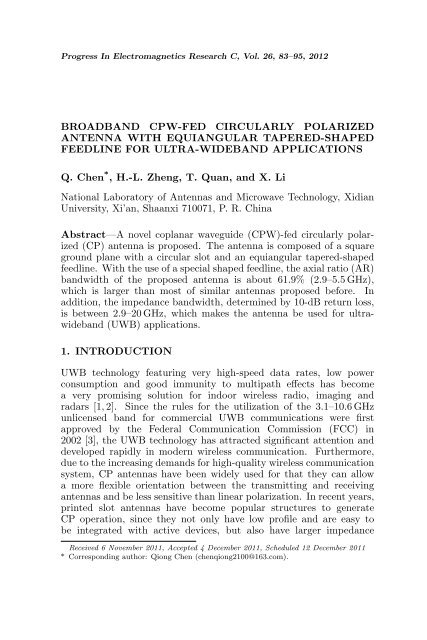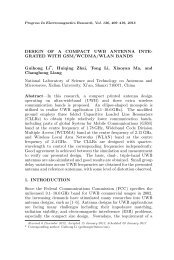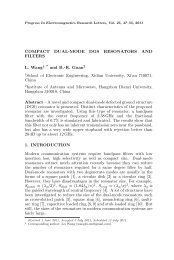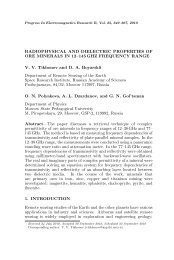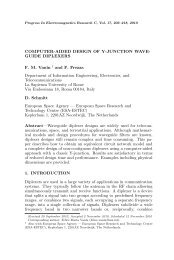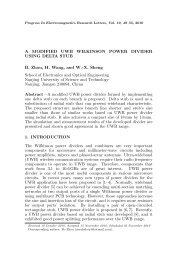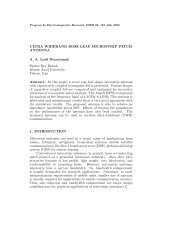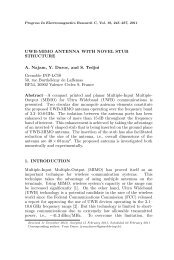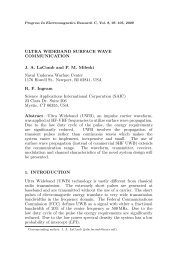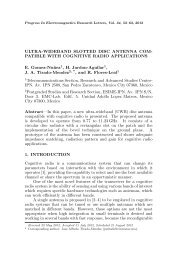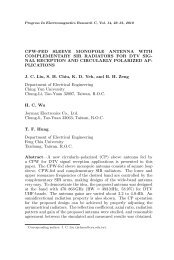BROADBAND CPW-FED CIRCULARLY POLARIZED ... - PIER
BROADBAND CPW-FED CIRCULARLY POLARIZED ... - PIER
BROADBAND CPW-FED CIRCULARLY POLARIZED ... - PIER
Create successful ePaper yourself
Turn your PDF publications into a flip-book with our unique Google optimized e-Paper software.
Progress In Electromagnetics Research C, Vol. 26, 83–95, 2012<br />
<strong>BROADBAND</strong> <strong>CPW</strong>-<strong>FED</strong> <strong>CIRCULARLY</strong> <strong>POLARIZED</strong><br />
ANTENNA WITH EQUIANGULAR TAPERED-SHAPED<br />
FEEDLINE FOR ULTRA-WIDEBAND APPLICATIONS<br />
Q. Chen * , H.-L. Zheng, T. Quan, and X. Li<br />
National Laboratory of Antennas and Microwave Technology, Xidian<br />
University, Xi’an, Shaanxi 710071, P. R. China<br />
Abstract—A novel coplanar waveguide (<strong>CPW</strong>)-fed circularly polarized<br />
(CP) antenna is proposed. The antenna is composed of a square<br />
ground plane with a circular slot and an equiangular tapered-shaped<br />
feedline. With the use of a special shaped feedline, the axial ratio (AR)<br />
bandwidth of the proposed antenna is about 61.9% (2.9–5.5 GHz),<br />
which is larger than most of similar antennas proposed before. In<br />
addition, the impedance bandwidth, determined by 10-dB return loss,<br />
is between 2.9–20 GHz, which makes the antenna be used for ultrawideband<br />
(UWB) applications.<br />
1. INTRODUCTION<br />
UWB technology featuring very high-speed data rates, low power<br />
consumption and good immunity to multipath effects has become<br />
a very promising solution for indoor wireless radio, imaging and<br />
radars [1, 2]. Since the rules for the utilization of the 3.1–10.6 GHz<br />
unlicensed band for commercial UWB communications were first<br />
approved by the Federal Communication Commission (FCC) in<br />
2002 [3], the UWB technology has attracted significant attention and<br />
developed rapidly in modern wireless communication. Furthermore,<br />
due to the increasing demands for high-quality wireless communication<br />
system, CP antennas have been widely used for that they can allow<br />
a more flexible orientation between the transmitting and receiving<br />
antennas and be less sensitive than linear polarization. In recent years,<br />
printed slot antennas have become popular structures to generate<br />
CP operation, since they not only have low profile and are easy to<br />
be integrated with active devices, but also have larger impedance<br />
Received 6 November 2011, Accepted 4 December 2011, Scheduled 12 December 2011<br />
* Corresponding author: Qiong Chen (chenqiong2100@163.com).
84 Chen et al.<br />
bandwidths compared with microstrip antennas [4, 5]. A <strong>CPW</strong>-fed<br />
square-ring slot antenna was designed by using a T-shaped metallic<br />
strip architecture in [6]. The construction, however, is limited with<br />
the 3-dB AR bandwidth, which is only 18%. To solve this problem,<br />
a novel design of <strong>CPW</strong>-fed antenna with a lightening-shaped feedline<br />
and two inverted-L grounded strips is described in [7] and the AR<br />
bandwidth is extended to 48.8%. As similar studies of the CP slot<br />
antennas, many other structures have also been proposed in [8–11].<br />
However, most of them can’t be used for UWB applications because<br />
of the limitation of impedance bandwidths.<br />
In many situations, the impedance and AR bandwidths of<br />
the slot antennas are mainly depended on the structures of the<br />
antennas’ feedlines or stubs. As spiral structures have travelingwave<br />
characteristic and can generate CP operation without the use<br />
of other CP techniques [12, 13], they are confirmed promising designs<br />
to enhance the bandwidths of slot antennas. In [14], as did the<br />
research in early years, a single spiral strip is used in microstrip slot<br />
antenna, but both the AR and impedance bandwidths are narrow.<br />
In [15], a single-arm equiangular tapered-shaped feedline is introduced<br />
and about 30% impedance bandwidth and 20% AR bandwidth are<br />
achieved. To further improve the performance, a similar structure<br />
of the feedline is applied to a backed-cavity antenna in [16], which<br />
is employed to generate a 2 × 2 array, and the AR and impedance<br />
bandwidths can be extended to 50% and 70%, respectively.<br />
In this paper, a novel <strong>CPW</strong>-fed CP antenna with an equiangular<br />
tapered feedline is proposed for UWB applications. In the antenna, a<br />
circular slot is etched in the centre of the square ground plane, and<br />
a single equiangular tapered feedline which was proposed in [15, 16] is<br />
implanted in the slot. By optimizing the dimensions of the structure,<br />
wide AR and impedance bandwidths are obtained. Details of the<br />
antenna design and the measured results of the constructed prototype<br />
are presented and discussed.<br />
2. ANTENNAS DESIGN<br />
The geometry of the proposed CP antenna is shown in Figure 1. As can<br />
be seen, the ground plane is printed on a square FR4 substrate with<br />
a relative permittivity of εr = 4.4 and a loss tangent of tan δ = 0.02.<br />
The length of the substrate is G, and the thickness is h. A circular slot<br />
with a diameter of Ds is etched in the ground plane. The circular slot<br />
is excited by a 50 Ohms <strong>CPW</strong> which is composed of a signal strip of<br />
width Wf = 3 mm and two identical gaps of width g = 0.35 mm. The<br />
equiangular tapered feedline implanted in the slot is used to couple the
Progress In Electromagnetics Research C, Vol. 26, 2012 85<br />
Figure 1. Geometry of the proposed <strong>CPW</strong>-fed slot antenna with<br />
tapered-shaped feedline. Antenna parameters: G = 60 mm, Ds =<br />
40 mm, Wn = 1 mm, Ln = 10 mm, Wf = 3 mm, g = 0.35 mm,<br />
h = 1.6 mm, C1: ρ = Rae −aΦ , Φ = [0, Φ0], C2: ρ = Rbe −bΦ ,<br />
Φ = [0, Φ0], where a = 0.27, b = 1 and Φ0 = 1.25π.<br />
electromagnetic energy into slot area from the feeding point [16]. And<br />
it is formed by two exponential curves C1 and C2, shown in Figure 1.<br />
The equations of the two curves can be expressed in polar coordinates<br />
as follows: � C1 : ρ = Rae −aΦ , Φ = [0, Φ0]<br />
C2 : ρ = Rbe −bΦ , Φ = [0, Φ0]<br />
where Ra equals a half of the diameter Ds, i.e., Ra = 1<br />
2 Ds, and Rb<br />
is a constant that remains to be optimized. a and b are the shrinking<br />
coefficients of curves C1 and C2, respectively. Φ0 is the common ending<br />
angle of curve C1 and C2. Adjusting the parameter a will lead to a<br />
variation of impedance matching performance, while the ending angle<br />
Φ0 has a great effect on CP bandwidth. By applying the structure<br />
of equiangular tapered feedline to the <strong>CPW</strong>-fed antenna, both the<br />
CP and impedance bandwidths are much wider than those <strong>CPW</strong>-fed<br />
antennas used other types of feedlines in [6–10]. To make the input<br />
impedance of the antenna match the impedance of the input port, a
86 Chen et al.<br />
Figure 2. The photograph of the proposed antenna.<br />
trapezoidal turning stub is embedded between the feeding structure<br />
and the tapered feedline. As shown in Figure 1, the trapezoid has a<br />
height of Ln, a bottom length of Wn and a top length of Wf which<br />
equals the width of the signal strip. An appropriate design of the<br />
turning stub will much widen the impedance bandwidth.<br />
In addition, the photograph of the manufactured antenna is shown<br />
in Figure 2.<br />
3. RESULTS AND DISCUSSIONS<br />
The proposed antenna is simulated by Ansoft HFSS simulation package<br />
and measured by Agilent E5071C vector network analyzer. Here, we<br />
let G = 60 mm, Ds = 40 mm, which are equal to the dimensions of<br />
ground plane and slot proposed in [7–11], respectively. Through out<br />
the studies presented in this section, all other parameters that haven’t<br />
been mentioned are fixed to the values shown in Figure 1.<br />
3.1. Mechanism of CP Operation and Impedance Matching<br />
The working principle of CP operation can be demonstrated by timevarying<br />
vector magnetic field distributions on the ground plane and<br />
feedline. Figure 3 shows the vector magnetic field distributions on the<br />
ground plane and the feedline at 4.2 GHz for four different instants,<br />
i.e., wt = 0 ◦ , 90 ◦ , 180 ◦ and 270 ◦ . It can be seen that at wt = 0 ◦ ,<br />
as the black color arrow shows, the dominant radiation magnetic field<br />
vector is in +x direction. After one quarter period when wt = 90 ◦ , the<br />
dominant radiation magnetic field vector changes to +y direction. It
Progress In Electromagnetics Research C, Vol. 26, 2012 87<br />
Figure 3. Simulated vector magnetic field distributions at 4.2 GHz.<br />
is noted that the vector magnetic field distributions at wt = 180 ◦ and<br />
270 ◦ are equal in magnitude and opposite in phase of wt = 0 ◦ and 90 ◦ ,<br />
respectively. Therefore, it can be concluded that the magnetic field<br />
vector rotates in the right-hand direction by 90 ◦ in +z direction after<br />
a quarter-period, which satisfies the requirement of the spatial and<br />
temporal quadrature for circular polarization. As for −z direction, the<br />
direction in which the magnetic field vector rotates is opposite to that<br />
of +z direction, i.e., the proposed CP slot antenna generates LHCP in<br />
−z direction while RHCP in +z direction.<br />
Figure 4 shows the real and imaginary parts of the input<br />
impedance and the coefficient reflection S11. As can be seen, the real<br />
part of the input impedance slightly fluctuates around 50 Ohms while<br />
the imaginary part around 0 Ohm at 2.9–20 GHz. And at 2.9–20 GHz,<br />
the coefficient reflection is below −10 dB as Figure 4 shows. That<br />
means the antenna has good impedance matching at this frequency<br />
band. Considering the traveling-wave structure of the tapered feedline,<br />
the input impedance should almost remain stable while frequencies<br />
keep increasing. Thus, the impedance matching can be extended to<br />
infinite high frequencies.
88 Chen et al.<br />
Figure 4. Simulated input impedance varying with frequency.<br />
3.2. Parametric Study of the Performance<br />
Before discussing other parameters, we first study the effect of ground<br />
size. In the process of varying the ground-plane size G but fixing the<br />
slot size Ds, we have found that the performance of the antenna is<br />
very sensitive to the ground-plane size, especially the CP operation.<br />
When G is set to 60 mm, equal to the dimension of ground plane<br />
proposed in [7–11], the AR bandwidth is 61.9% (2.9–5.5 GHz), and<br />
the lower impedance band frequency, defined by the lowest frequency<br />
for the reflection coefficient below −10 dB, is 2.9 GHz. If G increases to<br />
65 mm, dual-band CP performance can be achieved, which are 17.5%<br />
(2.6–3.1 GHz) and 25.9% (4.2–5.45 GHz), respectively. And the lower<br />
band frequency increases to 3.06 GHz. In this situation, the lower<br />
CP band 2.6–3.1 GHz is not enclosed by the impedance band(3.06–<br />
20 GHz). When G is set to 70 mm, the AR bandwidth decreases<br />
to 20.3% (4.2–5.15 GHz) while the lower impedance band frequency<br />
increases to 3.15 GHz.<br />
Since several other parameters affect the AR and return loss,<br />
here we only discuss about main effect parameters, including shrinking<br />
coefficient (a), ending angle (Φ0) of curves C1 and C2, height (Ln) and<br />
narrow bottom length (Wn) of trapezoidal turning stub. To simplify<br />
the effect of these parameters on the performance, we let Ra and Rb be<br />
fixed at its optimism values, which are 20 mm and 19 mm, respectively.<br />
Figure 5 shows the effects of parameter a on the reflection
Progress In Electromagnetics Research C, Vol. 26, 2012 89<br />
Figure 5. Simulated (a) S11 and (b) AR versus frequency for different<br />
values of parameter a.<br />
coefficient S11 and AR. It is clear that when parameter a increases, the<br />
lower band frequency, defined by the lowest frequency for the reflection<br />
coefficient below −10 dB, increases. And at higher frequencies, the<br />
reflection coefficient remains below −10 dB as a varies. We can also<br />
find the CP performance is also effected by a. And a good CP operation<br />
(a)<br />
(b)
90 Chen et al.<br />
which covers the frequency band of 2.9–5.5 GHz can be attained when<br />
a = 0.27.<br />
The key point to make sure the antenna radiates CP wave is to<br />
properly choose the ending angle Φ0 [14]. Figure 6 shows the effects of<br />
Figure 6. Simulated S11 and AR versus frequency for different values<br />
of parameter Φ0.<br />
Figure 7. Simulated S11 versus frequency for different values of Ln.
Progress In Electromagnetics Research C, Vol. 26, 2012 91<br />
ending angle Φ0 of curves C1 and C2 on the performance of the antenna.<br />
It can be seen that the S11 remains stable when Φ0 changes. The CP<br />
operation at the frequency band of 3.8–5.5 GHz, however, becomes bad<br />
as Φ0 varies from 1.25π to 2π. Best result is attained when Φ0 = 1.25π.<br />
Figure 7 shows the effects of the trapezoidal turning stub on<br />
Figure 8. Simulated and measured results of S11.<br />
Figure 9. Simulated and measured results of ARs.
92 Chen et al.<br />
the performance of the antenna. Wn is fixed at 1 mm, which is<br />
corresponding to 100 Ohms characteristic impedance [17]. As the stub<br />
is used to enhance impedance matching, it is only necessary to study<br />
its effect on reflection coefficient S11. As Figure 7 shows, the reflection<br />
coefficient decreases as Ln increases, and best result is obtained when<br />
Ln = 10 mm.<br />
3.3. Simulated and Measured Results<br />
Figure 8 shows the measured and simulated results of reflection<br />
coefficient at 2–20 GHz. From Figure 8, we can see that at the<br />
frequency band of 9–12 GHz, the measured S11 performance is not so<br />
highly agreement with the simulated results. Besides the fabrication<br />
error and the environments of the measurement which may cause this<br />
difference, the error occurring during the process of SMA connector<br />
(a)<br />
(b)<br />
Figure 10. Simulated and measured radiation patterns of the antenna<br />
at (a) 3.5 GHz, (b) 5.5 GHz.
Progress In Electromagnetics Research C, Vol. 26, 2012 93<br />
(Shown in Figure 2.) being welded will also lead to not so good result<br />
of the measured S11. Both the simulated and measured results show<br />
the −10 dB impedance bandwidth is about 2.9–20 GHz, and it could<br />
include infinite high frequencies as analyzed above.<br />
Figure 9 shows the measured and simulated results of AR. From<br />
the two curves, we can know both the measured and simulated results<br />
of AR ≤ 3 dB at 2.9–5.5 GHz, which means that the AR bandwidth<br />
can be up to 61.9%.<br />
Figure 10 shows the measured and simulated radiation patterns<br />
at 3.5 GHz and 5.5 GHz. It can be found that the patterns are RHCP<br />
for z > 0 and LHCP for z < 0, which is consistent with the vector<br />
magnetic field distribution shown in Figure 3. It also shows that the<br />
main beam direction shifts slightly away from the zenith, which is<br />
especially apparent at 5.5 GHz. This is because of the asymmetric<br />
structure of the antenna. As a result, the main beam direction will<br />
shift dramatically from the zenith as the working frequency increases.<br />
Figure 11 shows the simulated and measured radiation efficiency and<br />
maximum gains of the antenna. The use of low-loss FR4 substrate can<br />
lead to a high efficiency at operation band, as can be seen in the figure.<br />
Figure 11 also implies that the maximum gains are between 3–5 dBi<br />
within the 3-dB AR bandwidth from 2.9 to 5.5 GHz and will remain<br />
stable at 7 dBi as the frequency keeps increasing.<br />
Figure 11. Simulated and measured results of radiation efficiency and<br />
maximum gains.
94 Chen et al.<br />
4. CONCLUSION<br />
A <strong>CPW</strong>-fed CP antenna with ultra-wideband is proposed. The<br />
equiangular tapered-shaped feedline consists of two curves protruded<br />
from the <strong>CPW</strong>, and its structure contributes to the generation of CP<br />
radiation and UWB characteristic. The trapezoidal turning stub has<br />
effectively widened the impedance band. The impedance bandwidth<br />
of the proposed antenna is over 2.9–20 GHz (6.7 : 1), and the AR<br />
bandwidth is about 61.9% with a range of 2.9–5.5 GHz by the measured<br />
results. The maximum gains are about 3–5 dBi within the 3-dB AR<br />
bandwidth.<br />
REFERENCES<br />
1. Siwiak, K., “Ultra-wide band radio: Introducing a new<br />
technology,” IEEE Veh. Technol. Conf., Vol. 2, 1088–1093,<br />
May 2001.<br />
2. Leeper, D. G., “Ultra-wideband — the next step in short-range<br />
wireless,” IEEE Radio Freq. Integrated Circuits Symp. Dig., 493–<br />
496, Jun. 2003.<br />
3. “Federal communications commission revision of Part 15 of the<br />
Commission’s rules regarding ultra-wideband transmission system<br />
from 3.1 to 10.6 GHz,” Federal Communications Commission,<br />
FCC, ET-Docket, 98–153, Washington, DC, 2002.<br />
4. Row, J. S., “The design of a squarer-ring slot antenna for circular<br />
polarization,” IEEE Trans. Antennas Propag., Vol. 53, 1967–1972,<br />
Jun. 2005.<br />
5. Sze, J.-Y., C.-I. G. Hsu, M. H. Ho, Y. H. Ou, and M. T. Wu,<br />
“Design of circularly polarized annular-ring slot antennas fed by<br />
a double-bent microstrip line,” IEEE Trans. Antennas Propag.,<br />
Vol. 55, 3134–3139, Nov. 2007.<br />
6. Sze, J.-Y., K.-L. Wong, and C.-C. H. Coplanar, “Waveguide-fed<br />
square slot antenna for broadband circularly polarized radiation,”<br />
IEEE Trans. Antennas Propag., Vol. 51, No. 8, Aug. 2003.<br />
7. Sze, J.-Y., C.-I. G. Hsu, Z.-W. Chen, and C.-C. Chang,<br />
“Broadband <strong>CPW</strong>-fed circularly polarized square slot antenna<br />
with lightening-shaped feedline and inverted-L grounded strips,”<br />
IEEE Trans. Antennas Propag., Vol. 58, No. 3, 973–977,<br />
Mar. 2010.<br />
8. Liao, W. and Q.-X. Chu, “<strong>CPW</strong>-<strong>FED</strong> square slot antenna<br />
with lightening-shaped feedline for broadband circularly polarized
Progress In Electromagnetics Research C, Vol. 26, 2012 95<br />
radiation,” Progress In Electromagnetics Research Letters, Vol. 18,<br />
61–69, 2010.<br />
9. Sze, J.-Y. and C.-C. Chang, “Circularly polarized square slot<br />
antenna with a pair of inverted-L grounded strips,” IEEE<br />
Antennas and Wireless Propagation Letters, Vol. 7, 2008.<br />
10. Pourahmadazar, J., C. Ghobadi, J. Nourinia, N. Felegari, and<br />
H. Shirzad, “Broadband <strong>CPW</strong>-fed circularly polarized square slot<br />
antenna with inverted-L strips for UWB applications,” IEEE<br />
Antennas and Wireless Propagation Letters, Vol. 10, 369–372,<br />
May 2011.<br />
11. Felegari, N., J. Nourinia, C. Ghobadi, and J. Pourahmadazar,<br />
“Broadband <strong>CPW</strong>-fed circularly polarized square slot antenna<br />
with three inverted-L-shape grounded strips,” IEEE Antennas and<br />
Wireless Propagation Letters, Vol. 10, 2011.<br />
12. Zhang, Y. and L. Zhu, “Printed dual spiral-loop wire antenna for<br />
broadband circular polarization,” IEEE Trans. Antennas Propag.,<br />
Vol. 54, No. 1, 284–288, Jan. 2006.<br />
13. Buck, M. and D. Filipovic, “Bi-layer, mode 2, four-arm spiral<br />
antennas,” Electron. Lett., Vol. 43, No. 6, 1–2, Mar. 2007.<br />
14. Nakano, H., G. Hirokawa, J. Yamouchi, and K. Hirose, “Spiral<br />
antenna with coplanar strip line feed,” Electron. Lett., Vol. 28,<br />
No. 23, 2130–2131, 1992.<br />
15. Hung, K.-F. and Y.-C. Lin, “Simulation of single-arm fractional<br />
spiral antennas for millimeter wave applications,” IEEE Antennas<br />
and Propag. Society Symposium 2006, 3697–3700, Jul. 2006.<br />
16. Hung, K.-F. and Y.-C. Lin, “Novel broadband circularly polarized<br />
cavity-backed aperture antenna with traveling wave excitation,”<br />
IEEE Trans. Antennas Propag., Vol. 58, No. 1, Jan. 2010.<br />
17. Balanis, C. A., Antenna Theory: Analysis and Design, Wiley, New<br />
York, 2005.


